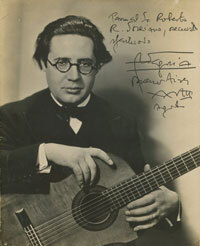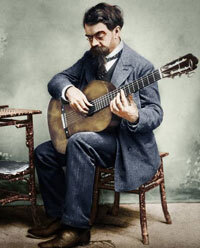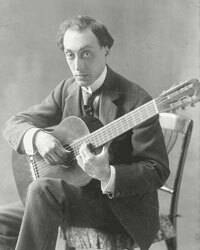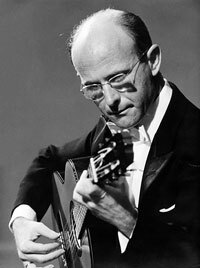Spanish Guitar Players
Who are the most legendary Spanish guitar players of all time? Classical guitar is sometimes called “the Spanish guitar” because of its history and its most important players. Spanish classical guitar music features technical virtuosity, fiery passion, and a deep cultural heritage running back to Medieval times. In this article we celebrate those Spanish maestros who have left a lasting influence on the history and repertoire of the classical guitar.
1. Andrés Segovia (1893-1987)
 Andrés Segovia, born in Linares, is known as the father of the classical guitar. While he inherited a rich legacy of music from nineteenth-century guitarists, that music never would have reached modern audiences without him. He took the guitar from being an instrument played in the home or in parlors and pubs to being a respected instrument in concert halls. Moreover, his expressive style of playing created a lasting influence on later generations and continue to shape the classical guitar’s legacy today.
Andrés Segovia, born in Linares, is known as the father of the classical guitar. While he inherited a rich legacy of music from nineteenth-century guitarists, that music never would have reached modern audiences without him. He took the guitar from being an instrument played in the home or in parlors and pubs to being a respected instrument in concert halls. Moreover, his expressive style of playing created a lasting influence on later generations and continue to shape the classical guitar’s legacy today.
Influence and Legacy:
- Repertoire: Segovia built up a sizable repertoire for the guitar through transcriptions and new commissions. He transcribed many classical works for guitar, such as Bach and Schumann, that had never been heard on the instrument before. But he also got many of the best composers of his day to write new music for the instrument.
- Concerts and Recordings: Segovia’s concerts drew thousands into large packed halls. He never amplified his guitar in these settings, which led to an intimate experience for his audiences. In addition to premiering new works and transcriptions in concerts, he went on to record numerous records over the course of fifty years.
- Education: Both in private lessons and in public masterclasses, Segovia influenced entire generations of new guitarists. In fact, at one point in time most classical guitarists either learned directly or indirectly from the great Spanish maestro.
2. Gaspar Sanz (1640-1710)
Gaspar Sanz, born in Calanda, was a baroque guitarist, composer, and teacher. He left one of the most important books of instruction for playing on the five-course baroque guitar. It included ninety compositions that shaped the rest of Spanish guitar history and repertoire.
Influence and Legacy:
- Compositions: Sanz’s compositions are some of the most important in today’s guitar repertoire, including “Españoleta,” “Rujero,” “Canarios,” and “Pavanas.”
- Techniques: Sanz pushed the guitar into a more contrapuntal direction with his right-hand technique, while still developing rasgueado strumming techniques, eventually combining these two approaches. He also developed a “campanella” (bells) approach where open strings and fretted notes overlap to create a resonant sound texture.
- Education: His book Instrucción de música sobre la guitarra española (1674) was one of the most influential pedagogical books in all of Spanish guitar history.
3. Fernando Sor (1778-1839)
Fernando Sor was one of the greatest virtuoso Spanish guitar players of his time, but he has left a much more lasting legacy as a composer than performer for the instrument. Once referred to as the “Beethoven of the Guitar,” Sor is best known for his Method book and his many etudes for students. He was born in Barcelona, but lived for a time in both London and Paris.
Influence and Legacy:
- Compositions: Sor’s extensive body of work includes études, sonatas, and variations that are essential to the classical guitar canon.
- Techniques: His innovative use of harmony and form significantly advanced the technical and expressive capabilities of the guitar.
- Teaching: Sor’s pedagogical works, such as his “Méthode pour la Guitare,” have educated generations of guitarists.
4. Francisco Tárrega (1852-1909)
 Francisco Tárrega, born in Villareal, is often regarded as the father of modern classical guitar technique. His contributions to guitar music and pedagogy are monumental.
Francisco Tárrega, born in Villareal, is often regarded as the father of modern classical guitar technique. His contributions to guitar music and pedagogy are monumental.
Influence and Legacy:
- Compositions: Works like “Recuerdos de la Alhambra” and “Capricho Árabe” are cornerstones of the classical guitar repertoire.
- Techniques: Tárrega developed new techniques, including the use of the right-hand fingers, which have become standard in classical guitar playing.
- Pedagogy: As a teacher, Tárrega influenced many students who would go on to become prominent guitarists, including Emilio Pujol and Miguel Llobet.
5. Miguel Llobet (1878-1938)
 Miguel Llobet, born in Barcelona, was a pioneering figure in the classical guitar world. He was a student of Francisco Tárrega and helped to elevate the guitar to new heights.
Miguel Llobet, born in Barcelona, was a pioneering figure in the classical guitar world. He was a student of Francisco Tárrega and helped to elevate the guitar to new heights.
Influence and Legacy:
- Transcriptions: Llobet’s transcriptions of popular Catalan folksongs as well as works of composers such as Albéniz and Granados expanded the guitar’s solo and duo repertoire.
- Compositions: His own works, including pieces like “Variaciones sobre un Tema del Sor,” are beloved staples of the classical guitar literature.
- Performances: Llobet’s performances across Europe and the Americas helped to popularize the classical guitar internationally.
6. Emilio Pujol (1886-1980)
Emilio Pujol, a student of Francisco Tárrega, was a significant figure in the classical guitar world. Pujol, born in Granadella, was a prolific performer, composer, and pedagogue.
Influence and Legacy:
- Compositions: Pujol’s works and arrangements, such as his “Escuela Razonada de la Guitarra,” are important contributions to the classical guitar literature.
- Teaching: Pujol’s teaching methods and publications have shaped the education of classical guitarists worldwide.
- Historical Research: Pujol’s research into early music and historical performance practice has enriched the understanding and repertoire of classical guitar.
7. Regino Sainz de la Maza (1896-1981)
Regino Sainz de la Maza, born in Burgos, was a prominent classical guitarist and composer. He is best known for premiering Joaquín Rodrigo’s “Concierto de Aranjuez.”
Influence and Legacy:
- Premieres: Sainz de la Maza’s premiere of “Concierto de Aranjuez” in 1940 is a landmark event in the history of classical guitar.
- Compositions: His own compositions, which often incorporate traditional Spanish elements, are an important part of the classical guitar repertoire.
- Teaching: Sainz de la Maza was also a dedicated teacher, mentoring many prominent guitarists of the next generation.
8. Narciso Yepes (1927-1997)
 Narciso Yepes, born in Lorca, was a virtuoso classical guitarist who popularized the ten-string guitar, an instrument he designed to extend the range of the traditional six-string guitar.
Narciso Yepes, born in Lorca, was a virtuoso classical guitarist who popularized the ten-string guitar, an instrument he designed to extend the range of the traditional six-string guitar.
Influence and Legacy:
- Film Music: Yepes’s performance of “Romanza” (or “Spanish Romance”) for the film Forbidden Games (Jeux Interdits) brought him international fame.
- Technical Innovations: Yepes is one of the first guitarists to use the a-m-i technique, using three right-hand fingers for scales. This allowed him to play fast scales similar to pianists and violinists, something previously difficult on the guitar.
- Recordings: His extensive discography includes seminal recordings of classical guitar repertoire, which continue to inspire guitarists.
9. Renata Tarragó (1927-2005)
Renata Tarragó, born in Barcelona to father Graciano Tarragó Pons (who was himself a composer, guitarist, and teacher), was a Catalan guitarist and vihuelist. She was one of the most important female Spanish guitarists of her time, making her debut recording with soprano Victoria de los Ángeles at a young age.
- Recordings: In addition to her recordings with Victoria de los Angeles, Tarragó was the first female guitarist to record the Concierto de Aranjuez in 1958. Even more significantly, she recorded the premiere of Federico Moreno-Torroba’s Concierto de Castilla in 1962.
- Teaching: Mostly known for her concertizing and recordings, Tarragó became Assistant Professor at the Barcelona Conservatory at the young age of seventeen. Her teaching legacy resounds through younger generations of especially female guitarists who studied with her.
- Vihuela: While she is known as a guitarist, Tarragó was also an accomplished vihuela and baroque guitar player.
10. Pepe Romero (1944-Present)
Pepe Romero, born in Málaga, is a classical and flamenco guitarist known for his exceptional technique and expressive performances. He is a member of the renowned Los Romeros guitar quartet.
Influence and Legacy:
- Teaching: Romero is a dedicated educator, having taught numerous students who have gone on to successful careers in music.
- Recordings: His extensive discography includes works from the classical and flamenco repertoires, showcasing his versatility and artistry.
- Family Legacy: The Romero family, known as “The Royal Family of the Guitar,” has had a profound influence on the world of guitar music.
Spanish Guitar Players outside Spain
Julian Bream (1933-2020)
Though British, Julian Bream had a profound influence on the Spanish classical guitar tradition. His interpretations of Spanish music and collaborations with Spanish composers brought a unique depth to the classical guitar repertoire.
Influence and Legacy:
- Collaborations: Bream worked closely with composers like Joaquín Rodrigo and Manuel de Falla, premiering many new works. He also worked closely with Spanish luthier José Romanillos.
- Recordings: His recordings of Spanish guitar music, particularly those of Enrique Granados and Isaac Albéniz, are considered definitive.
- Education: Bream’s dedication to the guitar has inspired countless musicians worldwide, bridging cultural and national divides.
John Williams (1941-Present)
Born in Australia, John Williams is one of the most technically proficient guitarists of all time. He has had a great influence on both the modern guitar repertoire and pedagogy.
Influence and Legacy:
- Recordings: Williams has recorded more than 150 albums, including several featuring Spanish guitar music. Most notably, he recorded a live concert from Sevilla for Sony called The Seville Concert, also released on DVD.
- Technique: John Williams is known for his pristine technical virtuosity, playing incredibly difficult pieces of music with ease.
- Commissions: He commissioned many new pieces for guitar, including works by Australian composers, as well as concertos by Peter Sculthorpe, André Previn, and Stephen Dodgson.
David Russell (1953-Present)
David Russell, although born in Scotland, moved to Menorca with his family when he was just five years old. Russell is celebrated for his interpretations of Spanish guitar music. His deep understanding of the Spanish classical guitar tradition has earned him a place among the greats.
Influence and Legacy:
- Awards: Russell has received numerous accolades, including a Grammy Award for Best Instrumental Soloist Performance.
- Recordings: His extensive discography includes critically acclaimed recordings of Spanish guitar music, including the solo guitar music of Regino Sainz de la Maza and Emilio Pujol.
- Concerts: Russell’s performances are renowned for their technical brilliance and emotional depth, captivating audiences around the world.
The contributions of these Spanish guitar players have profoundly shaped the classical guitar world. From the foundational innovations of Francisco Tárrega to the modern mastery of David Russell, each of these artists has left an indelible mark on the guitar’s history. Their legacies continue to inspire and influence new generations of guitarists, ensuring that the rich traditions of Spanish classical guitar music will endure for years to come.
Whether you’re a guitarist yourself or simply a lover of music, exploring the works of these legendary musicians is a journey worth taking. Their artistry and dedication to their craft are testaments to the enduring power and beauty of the Spanish classical guitar. Who is your favorite Spanish guitar player? Let us know in the comments below.

Leave A Comment